Abstract
The University of the Balearic Islands is undertaking a significant energy transition toward a zero-emissions model, motivated by escalating energy costs and strong institutional commitments to climate neutrality. This study investigates the technical and operational feasibility of deploying 7.1 MWp of photovoltaic capacity across the campus, integrated with Li-FePO4 battery systems and thermal energy storage. Through a detailed analysis of hourly energy demand, PV generation profiles, and storage constraints, the research evaluates how these technologies can be optimized to meet campus needs. A linear optimization model is applied to assess system performance under the constraint of a 3 MW grid export limit. Furthermore, the potential of demand-side electrification, implemented via a centralized HVAC plant and a 4th–5th generation district heating and cooling network, is analyzed in terms of its ability to maximize on-site PV self-consumption and reduce reliance on grid electricity during non-generation periods.
1. Introduction
The European Union (EU) has introduced the Green Deal [] as a strategic roadmap to promote sustainable development and achieve climate neutrality by 2050. A key focus of this initiative is decarbonization, which aims to accelerate the transition to renewable energy sources and reduce reliance on fossil fuels. By prioritizing greenhouse gas emission reductions, the Green Deal sets a clear path toward a more sustainable future. In line with these objectives, the University of the Balearic Islands (UIB) joined the United Nations Race to Zero campaign in 2021, committing to cut carbon emissions by 50% by 2030 and achieve net-zero emissions by 2050. Through these efforts, UIB aligns with the EU’s vision for a greener, more sustainable future. This is an extended version of the conference paper [].
As noted by Alghamdi et al. [], higher education institutions typically consume between three and five times more energy than primary or secondary schools. Additionally, according to Maiorano and Savan [], they may use up to 60% more electrical power than commercial buildings, with nearly half of this consumption allocated to maintaining thermal comfort []. This high energy demand presents both a challenge and an opportunity for institutions like UIB to lead by example in the energy transition.
Several universities have documented projects that incorporate renewable energy and advanced control strategies into their routine operations, providing valuable models for institutions such as UIB. For instance,
- Kim et al. [] described the use of model predictive control (MPC) at the University of California, Merced, where a central energy facility with five water-cooled chillers and a 4 MW solar array achieved a 25% reduction in excess photovoltaic output, a 10% drop in greenhouse gases, and a further 10% reduction in peak electricity consumption.
- Huylo et al. [] examined microgrid upgrades at the University of Texas at Austin, which already incorporates CHP, storage, and district-scale energy distribution. By integrating up to 200 MW of solar and wind, and transitioning turbines to partially use hydrogen, the system could reduce emissions by up to 54.7%.
- Wang et al. [] employed linear programming to optimize a CHP and solar thermal system with heat storage, revealing that storage usage is strongly influenced by heating needs and electricity price variability.
- Zhang et al. [] used a revised Lyapunov optimization algorithm to coordinate CHP, renewables, and grid interactions, reducing operational costs based on real-world performance.
- Firouzmakan et al. [] proposed a multi-objective optimization framework for energy management in microgrids, balancing reliability and sustainability under both islanded and grid-connected scenarios.
These cases exemplify how the strategic integration of renewables, energy storage, and intelligent control can yield substantial energy and emissions savings in higher education settings. Despite this potential, few investigations have examined advanced low-carbon networks in Mediterranean regions. Among them, Testasecca et al. [] studied a district heating system in Southern Italy integrating solar thermal and thermal energy storage, achieving energy savings of 62–82% compared to conventional systems. Calise et al. [] modelled a district heating network in Madrid powered by photovoltaics, heat pumps, and geothermal sources, reporting up to 98% emission reductions under optimal conditions. In a related study, Calise et al. [] analyzed a fifth-generation DHC system for a shopping mall in Spain, with dual neutral-temperature loops powered by photovoltaics, showing 89% primary energy savings and a payback period of 14.2 years. De Rosa et al. [] proposed an energy management model for a new district in Madrid, utilizing geothermal heat pumps to reduce non-renewable primary energy use by 66%, though high capital costs raised the levelized cost of energy.
Nevertheless, despite this documented progress, specific studies are still needed to characterize the thermal and energy performance of university infrastructures in warm climates, such as the case of UIB. Addressing this gap could contribute significantly to the broader understanding and adoption of sustainable energy systems in Southern European regions.
2. Case Study
The Technology of Computing Centre, the Scientific-Technical Centre, and the Livestock Centre are the three buildings with the highest energy consumption on campus (kWh/m2), with the latter two hosting numerous laboratories operating 24/7. Additionally, there are four buildings (13, 14, 15, 16 from Figure 1) connected to a third-generation district heating and cooling network sourced from a Technical Park situated 1.3 km from the campus with a Combined Heat and Power Plant []. The other buildings currently meet their thermal needs using reversible air-to-water heat pumps or independent individual units.
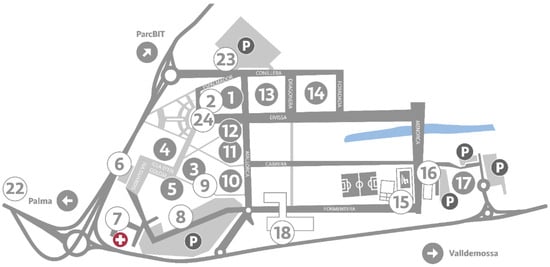
Figure 1.
Map of the campus with the buildings, numbers are listed in Table 1.
According to the climate change law, significant reductions are required to meet the 2020 and 2030 targets. This study analyzes the University’s energy consumption and CO2 emissions in recent years and proposes measures to achieve 100% renewable electricity consumption while enhancing energy efficiency.
To address these challenges, the UIB, in collaboration with multiple research groups, developed a strategy to reduce energy consumption and CO2 emissions by improving building energy efficiency, electrifying demand, and deploying a series of photovoltaic installations to generate 113% of the campus’s annual electricity consumption. Through projects aligned with this strategy, the UIB secured EUR 20.8 million in competitive funding from the Recovery and Resilience Facility (RRF), part of the EU’s Next Generation EU program, which supports investment and reforms in Member States for a sustainable and resilient recovery from the COVID-19 pandemic while advancing the EU’s green and digital priorities.
Given the abundant solar resource availability in the region and the proven reliability of photovoltaic technology [] the deployment of solar power is expected to expand significantly in the coming years. Currently, 0.14 MWp of the planned 7.1 MWp photovoltaic capacity has been installed at 18 locations across the campus. Figure 2 illustrates the distribution of these photovoltaic plants.

Figure 2.
Master plan with the PV estimated distribution and district heating and cooling design.
The system operation, including energy storage dynamics, was simulated using MATLAB R2022b, incorporating technical constraints such as nominal charge/discharge currents (140 A) and a battery depth of discharge of 80%. The simulation used a Typical Meteorological Year (TMY) from the IWEC (International Weather for Energy Calculations) dataset, corresponding to the Palma de Mallorca region.
By comparing PV production with the actual electricity consumption of the campus, specifically, the hourly electricity demand for the year 2023, it becomes evident that a strategy for managing and storing photovoltaic energy will be necessary, as generation is expected to range between 700 kW and 3 MW during peak periods. Figure 3 presents the battery charging management implemented in the simulator. In this image, the y-axis shows the identifier of each battery available in the system, which is being charged (yellow) or discharged (blue), while the x-axis represents the hour of the day during which charging or discharging occurs.
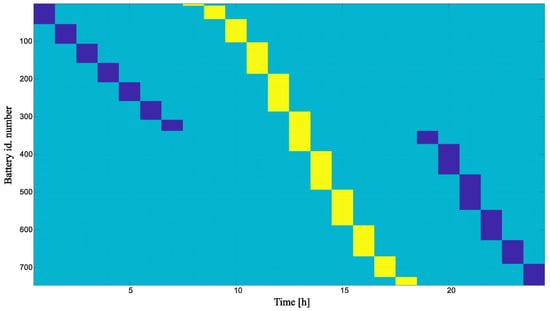
Figure 3.
Example of charge/discharge management of LiFePO4 batteries.
Additionally, as shown in Figure 4, the amount of photovoltaic energy that cannot be utilized (shaded red) is even greater than the energy that can be used instantly (shaded blue). Moreover, during hours without sunlight, there will be no photovoltaic production to meet the campus’s energy needs, meaning that electricity will have to be drawn from the grid (shaded yellow). Another challenge is that the campus’s medium-voltage evacuation line is limited to 3 MW by the Distribution System Operator (DSO), leading simulations to predict that 37.5% of generation hours will result in surpluses exceeding 3 MWh.
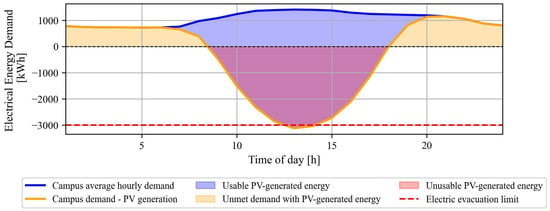
Figure 4.
Hourly electrical energy demand vs. PV production without energy storage.
Optimizing the campus’s energy management can be achieved by implementing 5.3 MWh of Li-FePO4 batteries. This solution would lower the annual hours in which generation surpluses exceed 3 MWh to just 7.5%, based on hourly simulations comparing expected photovoltaic generation with actual demand []. However, as seen in Figure 5, while this significantly improves the situation, it does not fully resolve the issue, as there remains a surplus of photovoltaic energy that cannot be utilized (pink shaded area), along with certain hours of the day when electricity still needs to be drawn from the grid (yellow shaded area).
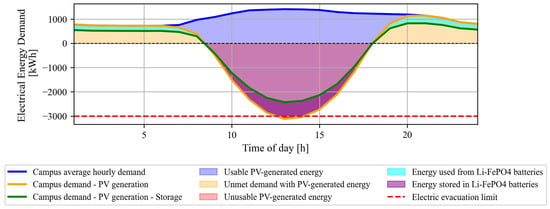
Figure 5.
Hourly electrical energy demand vs. PV production with Li-FePO4 batteries.
Knowing that 60% of the campus’s electricity demand is due to the heating and cooling of its buildings, studying how a new district heating and cooling (DHC) network based on heat pumps, combined with thermal energy storage (TES), can provide flexibility to the campus’s overall energy system becomes particularly relevant. This approach will be able to reduce electricity consumption from the grid while increasing self-consumption.
3. Materials and Methods
The methodology (view Figure 6) used to determine the optimal sizing of thermal and electrical energy storage is based on two main steps. First, a statistical analysis of charge and discharge cycles of an ideal thermal energy storage (TES) system is carried out to support the preliminary sizing of the TES. Second, a linear programming (LP) optimization problem is used to identify the optimal balance between TES and battery storage, aiming to meet thermal demand while minimizing operational costs.
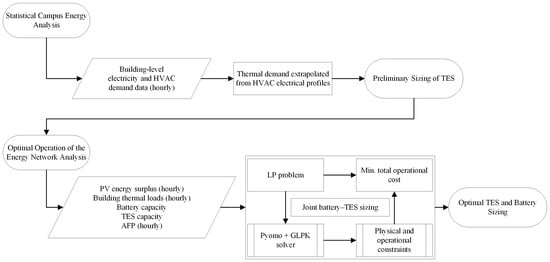
Figure 6.
Flowchart of the methodology followed in this study.
3.1. Statistical Analysis of Thermal Energy Storage Charging and Discharging Cycles
The first step of this study is to identify the potential of using TES throughout the campus to cover the thermal demand of the buildings at times when photovoltaic electricity surpluses are not available. In this initial scenario, which serves as an idealized baseline case, a series of assumptions are made based on the operation of a potential DHC network and the capacity for heating and cooling production.
Specifically, the storage capacity is assumed to be infinite, representing an ideal condition intended to evaluate the theoretical maximum potential of thermal energy storage. From a thermodynamic perspective, the storage system is considered a thermal energy reservoir capable of absorbing large amounts of energy without a change in temperature. This assumption allows the plant operation to be conceptualized in terms of distinct ‘charging’ and ‘discharging’ phases. Charging periods occur when there is a surplus of electricity generated by the photovoltaic system, whereas discharging periods take place when such surplus energy is not available. Thus, each charging cycle is followed by a discharging cycle, and the energy stored during a charging phase can only be used in the subsequent discharging period. For each charging and discharging cycle, only the minimum value between the stored and discharged energy is considered, ensuring an efficient management of thermal energy.
The objective is to determine the thermal demand that needs to be covered during hours when there is a surplus of electricity generated based on PV forecasting. During the hours when excess electricity must be evacuated, it is necessary to do so because the electrical demand for thermal needs is already being met, meaning the demand for those hours is covered. However, during the hours when there is no surplus electricity available, stored thermal energy would be required to cover the demand and avoid additional electricity consumption.
The first phase of the study focuses on estimating the number of times that charging and discharging cycles of different magnitudes of TES could be carried out throughout a year and what reduction in thermal consumption this would entail. To perform this analysis, the annual thermal demand, both for cooling and heating, of the campus buildings was extrapolated based on real, hourly-resolution HVAC electricity consumption data from the Anselm Turmeda building, measured during the entire year in 2023 (Table 1). This extrapolation is justified by the fact that all campus buildings are university facilities with similar usage profiles and occupancy patterns. Although there may be differences in the thermal envelope, especially in newer constructions, detailed information on the HVAC electricity consumption of each building was not available.

Table 1.
Electric energy consumption by building and peak thermal power by building extrapolated from the HVAC electrical demand of the Anselm Turmeda building.
3.2. Optimal Operation of the Energy Network
The second phase of the methodology focuses on assessing the operational expenses associated with electricity drawn from the grid to supply the HVAC thermal demand during periods without surplus PV generation, a process whose interaction is illustrated in Figure 7.
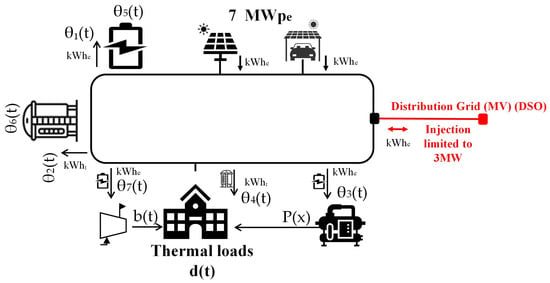
Figure 7.
Diagram of the interaction between variables in the optimization problem.
To optimize system performance, a time-based operational optimization model was developed for the central HVAC plant connected to the DHC network. This central unit consists of thermal production equipment, namely one or more heat pumps, and a distribution pump set that supplies conditioned energy to the connected buildings. An EER of 2.5 was used to represent the conversion efficiency between electrical input and thermal output.
The optimization problem was formulated using Pyomo 6.8.2 [], an open-source Python 3.11.9 library for algebraic modeling. The nonlinear nature of the energy balances required solving an LP problem, addressed using the GLPK solver [], which is tailored for large-scale linear systems. The model operates at an hourly time resolution, and the analysis focuses specifically on the cooling season, from May to October. This period was selected due to the higher thermal demand for space cooling compared to heating, and to reduce the computational burden of the simulation.
- θ1(t): Energy charged into the battery [kWhe];
- θ2(t): Energy charged into the TES [kWht];
- θ3(t): Battery discharge for HVAC thermal load [kWhe];
- θ4(t): TES discharge for HVAC thermal load [kWht];
- θ5(t): Battery state of charge [kWhe];
- θ6(t): TES state of charge [kWht];
- θ7(t): Battery discharge to support pumping load [kWhe].
The goal is to minimize the total cost of electricity consumed by the system throughout the evaluation period:
where
min C(θ) = Σt([P(d(t) − θ4(t)) + b(t) − θ3(t) − θ7(t))] × AFP(t))
- P(x): Converts thermal load to electrical input using EER [kWhe];
- d(t): Hourly thermal demand [kWht];
- b(t): Electrical consumption for pumping, with pumping costing 10% of thermal demand [kWhe];
- AFP(t): Hourly market electricity price in Spain for 2023 [€/kWhe].
The optimization model is governed by a set of technical constraints that define the operational limits of the system. Charging and discharging power levels are restricted: the battery can charge (θ1) or discharge (θ3) up to 1000 kWhe per hour, while the TES system is limited to 500 kWht per hour for both charging (θ2) and discharging (θ4).
The state of charge for both the battery (θ5) and the TES (θ6) is updated at each time step, accounting for respective charging and discharging efficiencies, and cannot exceed their maximum storage capacities. Energy cannot be stored if there is no available PV surplus at a given time. Furthermore, the battery and TES are not allowed to discharge more energy than was stored in the previous period. The system also ensures that the total thermal and electrical loads met by storage do not exceed the actual demand or system capacity.
Additional constraints guarantee that PV surplus utilization is coherent with storage activity and that the overall energy balance always remains non-negative.
A key feature of the model is that the maximum storage capacities of both the battery and the TES are not fixed. Instead, these values are systematically varied across simulations to explore a range of configurations. Each pair of capacities is tested under the following constraint:
Max(θ6) = 10,000 − 2.5 × max(θ5)
This approach allows for identifying the optimal trade-off between electrical and thermal storage capacity that minimizes the total operational energy cost of the system. This analysis is applied exclusively to the cooling demand period, where the system is subject to higher thermal loads and grid dependency is more critical. It should be noted that the analysis focuses solely on operational cost minimization.
4. Results
4.1. Complete Campus Results
Studying the thermal demand of the buildings of the entire campus in relation to the number of times that the thermal energy stored in an idealized TES could be used, we obtained the results shown in Figure 8.
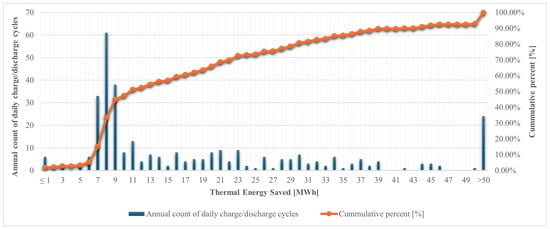
Figure 8.
Thermal energy demand covered by storage during periods of net photovoltaic surpluses.
It is important to highlight that the results in Figure 8 represent a scenario where the DHC is capable of supplying energy to all the buildings of the UIB without the aid of electrical batteries. However, this already allows us to visualize how the TES solution is a feasible option to cover thermal demands during hours when there are no photovoltaic surpluses, since the storage capacity of 16 MWht could cover 60% of the annual charge and discharge cycles, representing periods when the TES is charged from PV surplus and can subsequently be used to meet the entire thermal demand during the following PV deficit period, allowing it to meet more than 45% of the total annual thermal demand of the campus buildings.
Once the viability of TES as a highly useful system for the entire campus to complement photovoltaic production was determined, the study focused on how this would affect the thermal demand of the six buildings that will form a 4th–5th generation hybrid DHC network. In Figure 9, it can be observed how the storage capacity or the amount of energy that can be stored in the tanks in the form of chilled water would affect the percentage of thermal energy covered during the cooling months, allowing for a preliminary sizing of this tank.
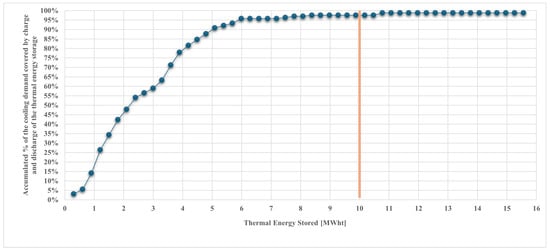
Figure 9.
Accumulated percentage of the cooling demand covered by charge and discharge of the thermal energy storage, depending on its size.
Along with the deployment of the photovoltaic park installation, the installation of 5.3 MWhe of Li-FePO4 batteries is planned. This means that the interaction between these two energy storage methods must be studied to determine which is the optimal size.
4.2. Optimal Sizing of Energy Storage System
After establishing that a storage capacity of 10 MWht is sufficient to meet 98% of the annual demand, the study focused on analyzing the relationship between the storage capacities of the TES and the Li-FePO4 batteries.
The results show that with a system fully based on TES for the 10 MWh of thermal energy storage, operational costs would amount to EUR 10,559.68, compared to EUR 65,080.45 in the absence of any energy storage method. Therefore, an 83.77% reduction in monetary costs during the space cooling period would be achievable.
When comparing the same total amount of storage (10 MWht) distributed differently between electrical batteries and TES, Figure 10 shows that allocating more than 50% of the total storage as thermal storage becomes a disadvantage. This is because with less electrical energy storage available, the pumping energy demand cannot be met using photovoltaic surplus and must instead be supplied from the grid, incurring additional costs.

Figure 10.
Operational costs of the DHC network with different percentages of TES and battery capacity.
This trade-off highlights the need for a hybrid storage strategy. While TES is ideal for shifting thermal loads, it cannot address the electricity requirements of auxiliary systems like circulation pumps or control equipment. Hence, a minimum threshold of battery storage is necessary to ensure that these loads can also be supplied from PV production, avoiding peak tariffs or emissions associated with grid electricity.
It has also been determined that beyond 1700 kWhe of electrical battery storage (red line in Figure 10), operational costs cannot be further reduced. At this point, the only way to achieve further reductions in operational costs would be by increasing the total storage capacity.
This plateau in cost savings indicates the presence of an optimal configuration where additional investment in storage, whether thermal or electrical, no longer translates into proportional economic benefit. From a planning perspective, this informs investment decisions by identifying a threshold beyond which storage oversizing yields diminishing returns.
5. Discussion
University campuses are uniquely positioned to serve as testbeds for renewable energy innovation due to their large surface areas, autonomous infrastructure management, and institutional commitments to sustainability [,]. Despite the considerable upfront investment required for renewable systems such as solar PV, the long-term advantages in terms of energy autonomy and reduced operational expenditure, particularly when bolstered by policy incentives, often validate the transition. Several institutions have already paved the way: Colorado State University installed 6.7 MW of solar PVs between 2009 and 2015, while Arizona State University deployed 24.1 MW of on-site and 28.8 MW of off-site solar generation. The University of California system collectively operates 36 MW of PV capacity, generating over 52 million kWh annually []. These examples illustrate both the feasibility and the replicability of campus-scale renewable energy transitions.
In alignment with this global trend, this study has demonstrated that transitioning the campus of the UIB to a 100% renewable and zero-emissions energy system is technically and economically viable, provided that strategic flexibility mechanisms are in place. A detailed analysis of hourly PV production, thermal and electrical demand, and storage dynamics confirmed the centrality of energy storage in overcoming grid export constraints. With the UIB’s grid connection limited to 3 MW by the DSO, the installation of 5.3 MWh of Li-FePO4 batteries significantly reduces the curtailment of solar energy but does not eliminate the surplus entirely.
Indeed, storing excess solar energy in thermal form is a compelling strategy, particularly when heat pump systems are already in place. In such cases, existing water tanks and the thermal inertia of buildings can be leveraged without major capital investment []. The role of heat pumps in maximizing PV self-consumption has been widely validated in the literature, with control strategies improving their alignment with solar generation [,,,]. Our findings show that implementing a TES system with a capacity of up to 16 MWht can meet approximately 45% of the campus’s annual thermal demand without additional electricity from the grid. This outcome underscores the dual advantage of minimizing solar energy curtailment while reducing reliance on grid-supplied electricity.
Simulation results indicate that dedicating over 50% of the total storage capacity to thermal energy storage leads to diminishing marginal benefits, due to unmet electrical demands such as pump operation. An optimal balance is achieved with approximately 1.7 MWhe in battery capacity, beyond which additional cost savings are negligible unless overall storage capacity is expanded. These results emphasize the importance of considering operational interactions between multiple storage technologies to optimize economic and energy performance. It should be noted that this comparison focuses exclusively on operational cost reduction; capital expenditures associated with storage technologies are not assessed, as investment cost analysis lies beyond the scope of this study.
While the simulations presented offer a robust indication of the technical and economic feasibility of transitioning the UIB campus to a fully renewable energy system, certain limitations must be acknowledged. The model relies on real hourly electricity consumption data from existing HVAC systems, providing a reliable basis for demand estimation. However, the extrapolation of thermal loads to all campus buildings introduces some uncertainty, particularly regarding envelope characteristics and thermal inertia, although building typologies, occupancy patterns, and schedules are largely homogeneous across the campus. Additionally, a constant average efficiency (EER = 2.5) was used to represent heat pump performance. This assumption was necessary due to the lack of detailed manufacturer data or empirical performance curves. Moreover, the installed PV capacity was not treated as a decision variable within the optimization process, as it corresponds to a system already planned for deployment on campus. While these simplifications and fixed assumptions inevitably influence specific outcomes as reflected by Chen et al. [], they fall within acceptable margins for system-level analysis and do not undermine the robustness of the overall conclusions.
Beyond the limitations of the modeling assumptions, additional risks may emerge during the system’s deployment, particularly regarding thermal demand alignment and storage integration. In hybrid systems relying on PV-powered heat pumps, a significant mismatch between actual and projected thermal loads can compromise the system’s ability to maximize self-consumption, as the alignment between demand and PV production curves is essential for leveraging thermal storage potential []. If real thermal demand is lower than expected, excess PV energy peaks may be more frequent, reducing economic viability. Furthermore, spatial constraints or structural incompatibilities may limit the feasibility of installing large-scale TES tanks. In such scenarios, reducing the required storage volume becomes critical, as shown by Zhang et al. [], who highlighted that the maximum feasible tank size is directly constrained by the campus’s available spatial resources. To mitigate these risks, implementing a phase deployment strategy with real-time monitoring, as well as considering decentralized or modular TES units, can help adapt the system to actual operating conditions while maintaining system flexibility.
Another essential aspect in campus decarbonization is addressing emissions from IT infrastructure, particularly data centers, which should be powered by carbon-free energy sources []. Furthermore, upgrading aging electrical systems, improving energy efficiency, and using carbon credits where appropriate can all contribute to institutional sustainability goals []. However, while carbon offsetting has its role, the priority must remain generating clean energy on site and ensuring the reliability of renewable systems, potentially through backup generation where necessary.
Ultimately, the deployment of a fourth–fifth generation DHC network at UIB significantly enhances system flexibility, enabling demand shifting and better alignment with variable PV production. This infrastructure not only supports short-term energy goals but also lays the foundation for a future campus-scale Virtual Power Plant (VPP), capable of participating in demand response markets and contributing to regional grid stability []. In parallel, these sustainability efforts position the university as a leader in climate action, strengthening its appeal to environmentally conscious students and stakeholders.
Beyond its specific application to the UIB campus, the proposed energy model offers a transferable approach for institutions situated in similar climatic and operational contexts. University campuses across the Mediterranean region typically exhibit comparable seasonal patterns in heating and cooling demand, as well as significant potential for photovoltaic generation due to high solar irradiance. These shared characteristics make the integration of PV systems, hybrid storage solutions, and low-temperature DHC infrastructure not only viable but also strategically aligned with the energy transition goals of many public institutions. In this sense, the UIB campus can serve as a blueprint for other Mediterranean universities aiming to combine sustainability, resilience, and cost-effectiveness in their energy systems.
Author Contributions
Conceptualization, P.A.B.-M. and A.M.-P.; methodology, P.A.B.-M. and V.C.; software, J.V.-N.; validation, I.A. and V.M.-M.; formal analysis, I.A.; investigation, A.M.-P.; resources, B.M.; data curation, Y.D.T.; writing—original draft preparation, P.A.B.-M. and J.V.-N.; writing—review and editing, A.M.-P.; visualization, V.C.; supervision, V.M.-M.; project administration, A.M.-P. and B.M.; funding acquisition, C.M.-F. and V.C. All authors have read and agreed to the published version of the manuscript.
Funding
This research received no external funding.
Institutional Review Board Statement
Not applicable.
Informed Consent Statement
Not applicable.
Data Availability Statement
The raw data supporting the conclusions of this article will be made available by the authors on request.
Acknowledgments
This work was carried out within the framework of a set of institutional projects at the University of the Balearic Islands, obtained through competitive funding calls. Specifically, this work is partially supported by the Plan to Promote the Recovery of Public Buildings (PIREP) through the PIREP Mateu Orfila and PIREP Ramon Llull projects, which aim to undertake sustainable rehabilitation actions for publicly owned and used buildings. These projects were submitted by the regional government of the Balearic Islands (Directorate General of Housing and Architecture) to the Spanish Ministry of Transport and Sustainable Mobility and are financed under Spain’s Recovery and Resilience Plan through the European Union’s NextGenerationEU funds. At the same time, this work was partially supported by the Investment Plan for Energy Transition in the Balearic Islands (PITEIB) through the PITEIB Innovators—1/2023 project. This project will enable the deployment of an innovative pilot project for a Virtual Power Plant on the UIB campus, allowing for efficient control and management of energy resources. This project was financed through a call by the Directorate General of Circular Economy, Energy Transition, and Climate Change of the regional government of the Balearic Islands, with funding from the Institute for the Diversification and Saving of Energy (IDAE) under Spain’s Recovery and Resilience Plan, through the European Union’s NextGenerationEU funds.
Conflicts of Interest
The authors declare no conflicts of interest.
Abbreviations
The following abbreviations are used in this manuscript:
| θ1(t) | Energy charged into the battery [kWhe] |
| θ2(t) | Energy charged into the TES [kWht] |
| θ3(t) | Battery discharge for HVAC thermal load [kWhe] |
| θ4(t) | TES discharge for HVAC thermal load [kWht] |
| θ5(t) | Battery state of charge [kWhe] |
| θ6(t) | TES state of charge [kWht] |
| θ7(t) | Battery discharge to support pumping load [kWhe] |
| P(x) | Converts thermal load to electrical input using EER [kWhe] |
| d(t) | Hourly thermal demand [kWht] |
| b(t) | Electrical consumption for pumping [kWhe] |
| MWhe | Electric Megawatt-hour |
| MWht | Thermal Megawatt-hour |
| GLPK | GNU Linear Programming Kit |
| LP | Linear Programming |
| AFP(t) | Hourly market electricity price in Spain |
| PITEIB | Investment Plan for Energy Transition in the Balearic Islands |
| PIREP | Plan to Promote the Recovery of Public Buildings |
| DSO | Distribution System Operator |
| IDAE | Institute for the Diversification and Saving of Energy |
| VPP | Virtual Power Plant |
| CO2 | Carbon Dioxide |
References
- Tsiropoulos, I.; Nijs, W.; Tarvydas, D.; Castello, P.R. Towards Net-Zero Emissions in the EU Energy System by 2050—Insights from Scenarios in Line with the 2030 and 2050 Ambitions of the European Green Deal; Publications Office of the European Union: Luxembourg, 2020. [Google Scholar]
- Bibiloni-Mulet, P.A.; Moià-Pol, A.; Vidal-Noguera, J.; Alonso, I.; Martínez-Moll, V.; Díaz Torres, Y.; Canals, V.; Mas, B.; Mulet-Forteza, C. Estudio de hibridación de energías fotovoltaica y térmica en la universitat de les illes balears para tener un balance cero de emisiones. In Proceedings of the XIX Congreso Ibérico y XV Congreso Iberoamericano de Energía Solar (CIES2024), Evora, Portugal, 19–21 June 2024. [Google Scholar]
- Alghamdi, A.; Hu, G.; Haider, H.; Hewage, K.; Sadiq, R. Benchmarking of Water, Energy, and Carbon Flows in Academic Buildings: A Fuzzy Clustering Approach. Sustainability 2020, 12, 4422. [Google Scholar] [CrossRef]
- Maiorano, J.; Savan, B. Barriers to energy efficiency and the uptake of green revolving funds in Canadian universities. Int. J. Sustain. High. Educ. 2015, 16, 200–216. [Google Scholar] [CrossRef]
- Shirazi, A.; Newton, S.; Christensen, P.H. Processing and Configuring Smart and Sustainable Building Management Practices in a University Building in Australia. Sustainability 2023, 15, 6194. [Google Scholar] [CrossRef]
- Kim, D.; Wang, Z.; Brugger, J.; Blum, D.; Wetter, M.; Hong, T.; Piette, M.A. Site demonstration and performance evaluation of MPC for a large chiller plant with TES for renewable energy integration and grid decarbonization. Appl. Energy 2022, 321, 119343. [Google Scholar] [CrossRef]
- Huylo, M.; Taheri, S.; Novoselac, A. Integration of renewable energy generation and storage systems for emissions reduction in an islanded campus microgrid. Build. Environ. 2025, 274, 112736. [Google Scholar] [CrossRef]
- Wang, H.; Yin, W.; Abdollahi, E.; Lahdelma, R.; Jiao, W. Modelling and optimization of CHP based district heating system with renewable energy production and energy storage. Appl. Energy 2015, 159, 401–421. [Google Scholar] [CrossRef]
- Zhang, G.; Cao, Y.; Cao, Y.; Li, D.; Wang, L. Optimal Energy Management for Microgrids with Combined Heat and Power (CHP) Generation, Energy Storages, and Renewable Energy Sources. Energies 2017, 10, 1288. [Google Scholar] [CrossRef]
- Firouzmakan, P.; Hooshmand, R.-A.; Bornapour, M.; Khodabakhshian, A. A comprehensive stochastic energy management system of micro-CHP units, renewable energy sources and storage systems in microgrids considering demand response programs. Renew. Sustain. Energy Rev. 2019, 108, 355–368. [Google Scholar] [CrossRef]
- Testasecca, T.; Catrini, P.; La Villetta, M.; Beccali, M.; Piacentino, A. Energy assessment of thermal solar-powered district heating and cooling networks for a cluster of buildings in Mediterranean climate. Renew. Energy 2025, 251, 123397. [Google Scholar] [CrossRef]
- Calise, F.; Cappiello, F.L.; Cimmino, L.; Dentice d’Accadia, M.; Vicidomini, M. A comparative thermoeconomic analysis of fourth generation and fifth generation district heating and cooling networks. Energy 2023, 284, 128561. [Google Scholar] [CrossRef]
- Calise, F.; Cappiello, F.L.; Cimmino, L.; Vicidomini, M.; Petrakopoulou, F. Thermoeconomic analysis of a novel topology of a 5th generation district energy network for a commercial user. Appl. Energy 2024, 371, 123718. [Google Scholar] [CrossRef]
- De Rosa, L.; Martínez, M.; Linares, J.I.; Mateo, C.; Gomez, T.; Cossent, R.; Postigo, F.; Sánchez-Miralles, Á.; Martín-Martínez, F. Design and assessment of energy infrastructure in new decarbonized urban districts: A Spanish case study. Energy Rep. 2024, 11, 4631–4641. [Google Scholar] [CrossRef]
- Moià-Pol, A.; Pujol-Nadal, R.; Martínez-Moll, V.; Hertel, J.D. Retrofit of a Solar System in Sport Center in Mallorca. Energy Procedia 2016, 91, 190–196. [Google Scholar] [CrossRef]
- Bulut, M. Integrated solar power project based on CSP and PV technologies for Southeast of Turkey. Int. J. Green Energy 2022, 19, 603–613. [Google Scholar] [CrossRef]
- Moll, V.M.; Bibiloni, P.A.; Vidal, J.; Canals, V.; Díaz-Torres, Y.; Moià-Pol, A.; Alonso, I.; Mas, B. Enhancing Energy Transition on Campus: Implementing Thermal Accumulation Mechanisms for Flexibility. In Proceedings of the EuroSun 2024: 15th International Conference on Solar Energy for Buildings and Industry, Limassol, Cyprus, 26–30 August 2024; pp. 1–12. [Google Scholar] [CrossRef]
- Bynum, M.L.; Hackebeil, G.A.; Hart, W.E.; Laird, C.D.; Nicholson, B.L.; Siirola, J.D.; Watson, J.-P.; Woodruff, D.L. Pyomo—Optimization Modeling in Python, 3rd ed.; Springer: Cham, Switzerland, 2021. [Google Scholar]
- Free Software Foundation. GLPK (GNU Linear Programming Kit). [Online]. Available online: https://www.gnu.org/software/glpk/glpk.html (accessed on 28 January 2025).
- Kalkan, N.; Bercin, K.; Cangul, O.; Morales, M.G.; Saleem, M.M.K.M.; Marji, I.; Metaxa, A.; Tsigkogianni, E. A renewable energy solution for Highfield Campus of University of Southampton. Renew. Sustain. Energy Rev. 2011, 15, 2940–2959. [Google Scholar] [CrossRef]
- Tu, Q.; Zhu, C.; McAvoy, D.C. Converting campus waste into renewable energy—A case study for the University of Cincinnati. Waste Manag. 2015, 39, 258–265. [Google Scholar] [CrossRef]
- Elgqvist, E.; VanGeet, O. Campus Energy Approach, REopt Overview, and Solar for Universities. In Proceedings of the 2017 I2SL Annual Conference, Boston, MA, USA, 15–18 October 2017. NREL/PR-7A40-70252. [Google Scholar]
- Zanetti, E.; Aprile, M.; Kum, D.; Scoccia, R.; Motta, M. Energy saving potentials of a photovoltaic assisted heat pump for hybrid building heating system via optimal control. J. Build. Eng. 2020, 27, 100854. [Google Scholar] [CrossRef]
- Péan, T.Q.; Salom, J.; Costa-Castelló, R. Review of control strategies for improving the energy flexibility provided by heat pump systems in buildings. J. Process. Control 2019, 74, 35–49. [Google Scholar] [CrossRef]
- Sayegh, M.A.; Jadwiszczak, P.; Axcell, B.P.; Niemierka, E.; Bryś, K.; Jouhara, H. Heat pump placement, connection and operational modes in European district heating. Energy Build. 2018, 166, 122–144. [Google Scholar] [CrossRef]
- Bach, B.; Werling, J.; Ommen, T.; Münster, M.; Morales, J.M.; Elmegaard, B. Integration of large-scale heat pumps in the district heating systems of Greater Copenhagen. Energy 2016, 107, 321–334. [Google Scholar] [CrossRef]
- Barco-Burgos, J.; Bruno, J.C.; Eicker, U.; Saldaña-Robles, A.L.; Alcántar-Camarena, V. Review on the integration of high-temperature heat pumps in district heating and cooling networks. Energy 2022, 239, 122378. [Google Scholar] [CrossRef]
- Chen, H.; Jia, X.; Wang, H.; Ning, Y.; Li, X.; Duanmu, L. Optimization and evaluation of a near-zero carbon energy system: Integration of photovoltaics, heat pumps, and combined thermal and electrical storage solutions. Energy Convers. Manag. 2025, 327, 119583. [Google Scholar] [CrossRef]
- Bandera, C.F.; Pachano, J.; Salom, J.; Peppas, A.; Ruiz, G.R. Photovoltaic plant optimization to leverage electric self consumption by harnessing building thermal mass. Sustainability 2020, 12, 553. [Google Scholar] [CrossRef]
- Zhang, R.; Li, Z.; Liu, P. Modeling and optimization of a heating and cooling combined seasonal thermal energy storage system towards a carbon-neutral community: A university campus case study. Energy 2025, 319, 135122. [Google Scholar] [CrossRef]
- University of Minnesota. Twin Cities Climate Action Plan 2023. Twin Cities. 2023. Available online: https://sustainable.umn.edu/sites/sustainable.umn.edu/files/2023-07/Twin%20Cities%20Climate%20Action%20Plan%2020230720.pdf (accessed on 28 March 2025).
- Kiehle, J.; Kopsakangas-Savolainen, M.; Hilli, M.; Pongrácz, E. Carbon footprint at institutions of higher education: The case of the University of Oulu. J. Environ. Manag. 2023, 329, 117056. [Google Scholar] [CrossRef]
- Patteeuw, D.; Henze, G.P.; Helsen, L. Comparison of load shifting incentives for low-energy buildings with heat pumps to attain grid flexibility benefits. Appl. Energy 2016, 167, 80–92. [Google Scholar] [CrossRef]
Disclaimer/Publisher’s Note: The statements, opinions and data contained in all publications are solely those of the individual author(s) and contributor(s) and not of MDPI and/or the editor(s). MDPI and/or the editor(s) disclaim responsibility for any injury to people or property resulting from any ideas, methods, instructions or products referred to in the content. |
© 2025 by the authors. Licensee MDPI, Basel, Switzerland. This article is an open access article distributed under the terms and conditions of the Creative Commons Attribution (CC BY) license (https://creativecommons.org/licenses/by/4.0/).